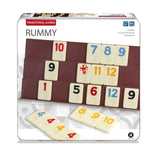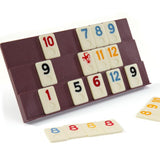





- AED 104.00
- AED 104.00
- Unit price
- per
Interest-free installments available.
Extra 10% | WELCOME10

Extra 15% | XMAS15

Get 175 Off | SAVE175

Couldn't load pickup availability
Collection of premium Roman tiles from Ambassador. is packaged in a gorgeous box. - Perfect for ensuring the security of your strategic family rummy game when not in use.
Make your free time enjoyable as well as creative with the Classic Rummy. It features stunning gold-foil gift box that includes thick, plastic rummy tiles with painted numbers and 4 large plastic trays. It is wonderful addition to enhance your kid's knowledge in numbers. This game entertains your children and encourages them to confidence in winning.
The ideal board game for kids and great family entertainment. - For people 6 years of age and older.
Features:
• Improves critical thinking skills
• Includes rummy tiles and plastic trays
• Entertains and educates
• Develop reasoning skills
• Encourage their confidence in numbers
Overview
Product Dimensions: 27.5 x 19 x 6.5 cm
Package Dimensions: 6.7 x 19.4 x 27.6 cm
Weight: 1.24KG
Recommended Age: Suitable for 6 years & above
Cautions: Not suitable for children under 3 years old. Only for domestic use. To be used under the direct supervision of an adult.
Related Products
- AED 104.00
- AED 104.00
- Unit price
- per
- AED 104.00
- AED 104.00
- Unit price
- per
- AED 104.00
- AED 104.00
- Unit price
- per
- AED 104.00
- AED 104.00
- Unit price
- per
- AED 104.00
- AED 104.00
- Unit price
- per
- AED 104.00
- AED 104.00
- Unit price
- per
- AED 104.00
- AED 104.00
- Unit price
- per
- AED 104.00
- AED 104.00
- Unit price
- per
- AED 104.00
- AED 104.00
- Unit price
- per
- AED 104.00
- AED 104.00
- Unit price
- per
Recently Viewed Products
- AED 104.00
- AED 104.00
- Unit price
- per
- AED 104.00
- AED 104.00
- Unit price
- per
- AED 104.00
- AED 104.00
- Unit price
- per
- AED 104.00
- AED 104.00
- Unit price
- per
- AED 104.00
- AED 104.00
- Unit price
- per
- AED 104.00
- AED 104.00
- Unit price
- per
- AED 104.00
- AED 104.00
- Unit price
- per
- AED 104.00
- AED 104.00
- Unit price
- per
- AED 104.00
- AED 104.00
- Unit price
- per
- AED 104.00
- AED 104.00
- Unit price
- per
- Choosing a selection results in a full page refresh.











